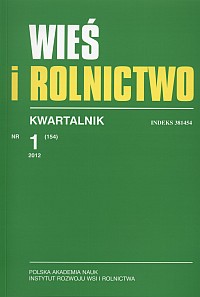Economic situation of dairy farms after liquidation of the system of milk production quotas
DOI:
https://doi.org/10.53098/wir.2012.1.154/07Keywords:
profitability, dairy farms, production costs, milk production quotasAbstract
In step with the European Union's new budget perspective for 2014–2020 changes will be taking place in the Common Agricultural Policy. One of these changes will be the liquidation of the system of milk production quotas. It is predicted that in the result of the liquidation of the quota system the production of milk on the EU market will grow, which is likely to lead to a decrease in its procurement price. The article marks an attempt at determining the future economic situation of dairy farms, which is certain to be affected by the indicated changes. Research was conducted on the basis of model farms specializing in milk production and representing different volumes of production. In order to determine the income situation of the examined farms in 2014 and 2020 definite assumptions relating to the future costs of production means, productivity and milk procurement prices were adopted. The results of the simulation have shown that between 2014 and 2020 the incomes of all the analysed farms will decrease. The greatest fall will be experienced by farms having the smallest herds of dairy cows. Their operation will be barely profitable. The rest of the analysed model farms may record in 2020 a decline in profitability of between 20% and 30% in comparison with 2014. Such situation will compel milk producers to take strategic decisions concerning the possibilities of their further operation.References
Baer-Nawrocka A., Kiryluk-Dryjska E., 2010: Wpływ likwidacji kwot mlecznych na sytuację produkcyjną i ekonomiczną producentów mleka w Unii Europejskiej (wyniki symulacji modelowych). „Wieś i Rolnictwo” 3 (148). DOI: https://doi.org/10.53098/wir.2010.3.148/09
Bartova L., Fellmann T., M’barek R., 2009: Modelling and Analysis of the European Milk and Dairy Market. Joint Research Centre – Institute for Prospective Technological Studies, Office for Official Publications of the European Communities, EUR 23833 EN/1, Luksemburg.
Bouamra-Mechemache Z., Jongeneel R., Requillart V., 2008: Removing EU milk quotas, soft landing versus hard landing (http://ideas.repec.org/p/ags/eaae08/43656.html – październik 2011).
CAP Health Check – Impact Assessment Note No 6, G. 1. Agricultural policy analysis and perspectives, 2008. European Commission, Directorate-General Agriculture and Rural Development, Brussels.
COM (2010) 728 final. Brussels 09.12.2010, European Commission
Hemme T., Borbély Cs., Csorbai A., 1999: Comparison of typical Hungarian and German Dairy Farms. ”Acta Agreria Kaposvarensis” 3,3.
Hemme T., Isermeyer., Deblitz C., 1997: TIPI-CAL Version 1.0: ein Modell zur Politik- und Technik-folgenabschätzung für typische Betriebe im internationalen Vergleich Arbeitsbericht. Institut für Betriebswirtschaft 97/02, Braunschweig.
Mańko S., Goraj L., 2011: Model szacowania pełnych kosztów działalności gospodarstw rolnych. „Zagadnienie Ekonomiki Rolnej” 3.
Report of the High Level Group on Milk 2010 final version 15 June 2010 (http://ec.europa.eu/agriculture/markets/milk/hlg/ – październik 2011).
Réquillart V., 2008: Economic Analysis of the Effects of the Expiry of the EU Milk Quota System. IDEI, Toulouse.
Skarżyńska A., Augustyńska-Grzymek I., 2001: Koszty jednostkowe i dochodowość produkcji rolniczej w gospodarstwach indywidualnych w 2000 roku. IERiGŻ, Warszawa.
Wilczyński A., Karolewska M., 2007: Rozwój i opłacalność produkcji żywca wołowego w latach 2003-2005 w wybranych krajach UE. „Folia Univ. Agric. Stetin. 254, Oecon. 47: 341–346.
Zeliaś A., Pawełek B., Wanat S., 2004: Prognozowanie ekonomiczne. Wydawnictwo Naukowe PWN, Warszawa.
Zwierzęta gospodarskie i wybrane elementy metod produkcji zwierzęcej. Powszechny spis rolny 2010, 2011. GUS, Warszawa. DOI: https://doi.org/10.59139/ws.2011.10.2
Downloads
Article file downloads
Pages
How to Cite
Issue
Section
License
Copyright (c) 2012 Wieś i Rolnictwo

This work is licensed under a Creative Commons Attribution 4.0 International License.










